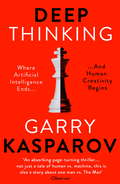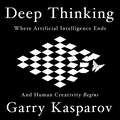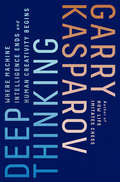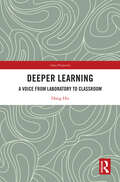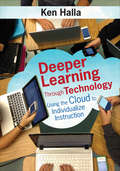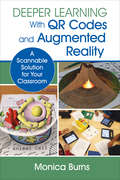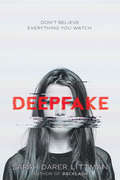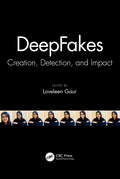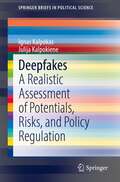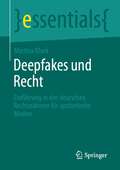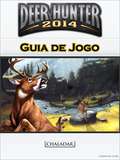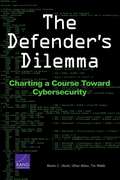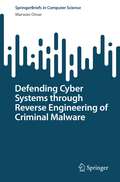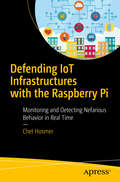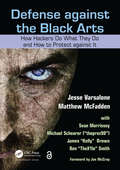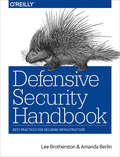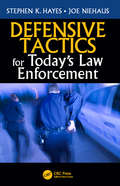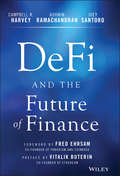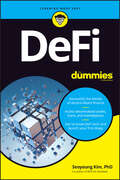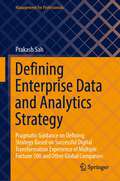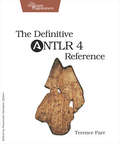- Table View
- List View
Deep Thinking: Where Machine Intelligence Ends and Human Creativity Begins
by Garry KasparovIn May 1997, the world watched as Garry Kasparov, the greatest chess player in the world, was defeated for the first time by the IBM supercomputer Deep Blue. It was a watershed moment in the history of technology: machine intelligence had arrived at the point where it could best human intellect.It wasn't a coincidence that Kasparov became the symbol of man's fight against the machines. Chess has long been the fulcrum in development of machine intelligence; the hoax automaton 'The Turk' in the 18th century and Alan Turing's first chess program in 1952 were two early examples of the quest for machines to think like humans -- a talent we measured by their ability to beat their creators at chess. As the pre-eminent chessmaster of the 80s and 90s, it was Kasparov's blessing and his curse to play against each generation's strongest computer champions, contributing to their development and advancing the field. Like all passionate competitors, Kasparov has taken his defeat and learned from it. He has devoted much energy to devising ways in which humans can partner with machines in order to produce results better than either can achieve alone. During the twenty years since playing Deep Blue, he's played both with and against machines, learning a great deal about our vital relationship with our most remarkable creations. Ultimately, he's become convinced that by embracing the competition between human and machine intelligence, we can spend less time worrying about being replaced and more thinking of new challenges to conquer.In this breakthrough book, Kasparov tells his side of the story of Deep Blue for the first time -- what it was like to strategize against an implacable, untiring opponent -- the mistakes he made and the reasons the odds were against him. But more than that, he tells his story of AI more generally, and how he's evolved to embrace it, taking part in an urgent debate with philosophers worried about human values, programmers creating self-learning neural networks, and engineers of cutting edge robotics.
Deep Thinking: Where Machine Intelligence Ends and Human Creativity Begins
by Garry KasparovGarry Kasparov gives his first public account of his landmark 1997 chess match with the IBM supercomputer Deep Blue, and explains why, twenty years later, he's become convinced that artificial intelligence is good for humans.In May 1997, the world watched as Garry Kasparov, the greatest chess player in the world, was defeated for the first time by the IBM supercomputer Deep Blue. It was a watershed moment in the history of technology: machine intelligence had arrived at the point where it could best human intellect.It wasn't a coincidence that Kasparov became the symbol of man's fight against the machines. Chess has long been the fulcrum in development of machine intelligence; the hoax automaton 'The Turk' in the 18th century and Alan Turing's first chess program in 1952 were two early examples of the quest for machines to think like humans - a talent we measured by their ability to beat their creators at chess. As the pre-eminent chessmaster of the 80s and 90s, it was Kasparov's blessing and his curse to play against each generation's strongest computer champions, contributing to their development and advancing the field. Like all passionate competitors, Kasparov has taken his defeat and learned from it. He has devoted much energy to devising ways in which humans can partner with machines in order to produce results better than either can achieve alone. During the twenty years since playing Deep Blue, he's played both with and against machines, learning a great deal about our vital relationship with our most remarkable creations. Ultimately, he's become convinced that by embracing the competition between human and machine intelligence, we can spend less time worrying about being replaced and more thinking of new challenges to conquer.In this breakthrough book, Kasparov tells his side of the story of Deep Blue for the first time - what it was like to strategize against an implacable, untiring opponent - the mistakes he made and the reasons the odds were against him. But more than that, he tells his story of AI more generally, and how he's evolved to embrace it, taking part in an urgent debate with philosophers worried about human values, programmers creating self-learning neural networks, and engineers of cutting edge robotics.(P)2017 Hachette Audio
Deep Thinking: Where Machine Intelligence Ends and Human Creativity Begins
by Garry Kasparov Mig GreengardGarry Kasparov's 1997 chess match against the IBM supercomputer Deep Blue was a watershed moment in the history of technology. It was the dawn of a new era in artificial intelligence: a machine capable of beating the reigning human champion at this most cerebral game. That moment was more than a century in the making, and in this breakthrough book, Kasparov reveals his astonishing side of the story for the first time. He describes how it felt to strategize against an implacable, untiring opponent with the whole world watching, and recounts the history of machine intelligence through the microcosm of chess, considered by generations of scientific pioneers to be a key to unlocking the secrets of human and machine cognition. Kasparov uses his unrivaled experience to look into the future of intelligent machines and sees it bright with possibility. As many critics decry artificial intelligence as a menace, particularly to human jobs, Kasparov shows how humanity can rise to new heights with the help of our most extraordinary creations, rather than fear them. Deep Thinking is a tightly argued case for technological progress, from the man who stood at its precipice with his own career at stake.
Deeper Learning: A Voice from Laboratory to Classroom (China Perspectives)
by Hang HuIntegrating brain science, cognitive psychology, education and information technology, the books studies how technology promoted deeper learning on mathematics in Chinese primary schools. After introducing the theoretical basis, connotation and mechanism of deeper learning, the author fully explains its practice, including the composition of deeper learning teaching content, the development of digital resources, classroom teaching technology and teachers' professional development of deeper learning. He especially adopts multiple and interdisciplinary research methods, such as deeper learning "triangle evidence" paradigm, learning brain observation, education big data analysis, artificial intelligence education analysis, education action, qualitative and quantitative research. On one hand, the book will give researchers of learning theory and pedagogy an in-depth understanding of what deeper learning is and why it provides a systematic theoretical system; on the other hand, it will also provide school practitioners with operational methods and cases to learn from.
Deeper Learning Through Technology: Using the Cloud to Individualize Instruction
by Mr Kenneth P. HallaUse the Cloud to Individualize Your Instruction and Watch Your Students Thrive! Cloud-based technology offers massive benefits to the classroom. But technology tools require conscientious implementation by educators. This book is the all-in-one resource you need to be sure your students reap the fullest rewards of how cloud-based tools can facilitate learning. In Deeper Learning Through Technology, teacher and top ed-blogger Ken Halla explains: How to implement new tech tools to create a self-paced, learner-centered classroom Strategies for leveraging cloud technology to ensure that students have access to an individualized, personalized education Real-life case studies and activities that will make applying the book’s strategies to your classroom enjoyable and achievable
Deeper Learning Through Technology: Using the Cloud to Individualize Instruction
by Mr Kenneth P. HallaUse the Cloud to Individualize Your Instruction and Watch Your Students Thrive! Cloud-based technology offers massive benefits to the classroom. But technology tools require conscientious implementation by educators. This book is the all-in-one resource you need to be sure your students reap the fullest rewards of how cloud-based tools can facilitate learning. In Deeper Learning Through Technology, teacher and top ed-blogger Ken Halla explains: How to implement new tech tools to create a self-paced, learner-centered classroom Strategies for leveraging cloud technology to ensure that students have access to an individualized, personalized education Real-life case studies and activities that will make applying the book’s strategies to your classroom enjoyable and achievable
Deeper Learning Through Technology: Using the Cloud to Individualize Instruction
by Mr. Kenneth P. HallaUse the Cloud to Individualize Your Instruction and Watch Your Students Thrive! Cloud-based technology offers massive benefits to the classroom. But technology tools require conscientious implementation by educators. This book is the all-in-one resource you need to be sure your students reap the fullest rewards of how cloud-based tools can facilitate learning. In Deeper Learning Through Technology, teacher and top ed-blogger Ken Halla explains: How to implement new tech tools to create a self-paced, learner-centered classroom Strategies for leveraging cloud technology to ensure that students have access to an individualized, personalized education Real-life case studies and activities that will make applying the book’s strategies to your classroom enjoyable and achievable
Deeper Learning Through Technology: Using the Cloud to Individualize Instruction
by Mr. Kenneth P. HallaUse the Cloud to Individualize Your Instruction and Watch Your Students Thrive! Cloud-based technology offers massive benefits to the classroom. But technology tools require conscientious implementation by educators. This book is the all-in-one resource you need to be sure your students reap the fullest rewards of how cloud-based tools can facilitate learning. In Deeper Learning Through Technology, teacher and top ed-blogger Ken Halla explains: How to implement new tech tools to create a self-paced, learner-centered classroom Strategies for leveraging cloud technology to ensure that students have access to an individualized, personalized education Real-life case studies and activities that will make applying the book’s strategies to your classroom enjoyable and achievable
Deeper Learning With QR Codes and Augmented Reality: A Scannable Solution for Your Classroom (Corwin Teaching Essentials)
by Monica BurnsEngaging, interactive learning—right in your students’ hands! What if your students’ mobile devices became an instructional asset rather than a distraction? Discover how free, scannable technology can enrich learning, while captivating students. Best of all, these technologies are easy to quickly implement within your classroom. Learn about QR codes and Augmented Reality (AR) Reach each student with new, hands-on learning opportunities Embrace the ACES Framework for teaching with scannable technologies: Access, Curate, Engage, and Share Promote self-directed learning and showcase students’ creations Leverage technology to connect classroom activities with students’ families and the broader community
Deeper Learning With QR Codes and Augmented Reality: A Scannable Solution for Your Classroom (Corwin Teaching Essentials)
by Monica BurnsEngaging, interactive learning—right in your students’ hands! What if your students’ mobile devices became an instructional asset rather than a distraction? Discover how free, scannable technology can enrich learning, while captivating students. Best of all, these technologies are easy to quickly implement within your classroom. Learn about QR codes and Augmented Reality (AR) Reach each student with new, hands-on learning opportunities Embrace the ACES Framework for teaching with scannable technologies: Access, Curate, Engage, and Share Promote self-directed learning and showcase students’ creations Leverage technology to connect classroom activities with students’ families and the broader community
Deepfake
by Sarah Darer LittmanDara Simons and Will Halpern have everything they've ever wanted. They are the rulers of Greenpoint High's geekdom, overachieving in every way, and it's an intense competition to see who will be valedictorian. One the entire school is invested in. That is, until Rumor Has It, the anonymous gossip site, posts a video of Dara accusing Will of paying someone to take the SAT for him.When the video goes viral, suddenly Will's being investigated, and everyone's wondering how he pulled off cheating on the SAT. But Dara swears that she didn't say any of those things, which seems a little hard to believe since it's her in the video.Did Will cheat?Is it Dara saying he did?Who's lying, and who's telling the truth?The answer is more shocking than anyone realizes...
DeepFakes: Creation, Detection, and Impact
by Loveleen GaurDeepfakes is a synthetic media that leverage powerful Artificial Intelligence (AI) and machine learning (ML) techniques to generate fake visual and audio content that are extremely realistic, thus making it very hard for a human to distinguish from the original ones. Apart from technological introduction to the Deepfakes concept, the book details algorithms to detect Deepfakes, techniques for identifying manipulated content and identifying face swap, generative adversarial neural networks, media forensic techniques, deep learning architectures, forensic analysis of DeepFakes and so forth. Provides a technical introduction to DeepFakes, its benefits, and the potential harms Presents practical approaches of creation and detection of DeepFakes using Deep Learning (DL) Techniques Draws attention towards various challenging issues and societal impact of DeepFakes with their existing solutions Includes research analysis in the domain of DL fakes for assisting the creation and detection of DeepFakes applications Discusses future research directions with emergence of DeepFakes technology This book is aimed at graduate students, researchers and professionals in data science, artificial intelligence, computer vision, and machine learning.
Deepfakes: A Realistic Assessment of Potentials, Risks, and Policy Regulation (SpringerBriefs in Political Science)
by Ignas Kalpokas Julija KalpokieneThis book examines the use and potential impact of deepfakes, a type of synthetic computer-generated media, primarily images and videos, capable of both creating artificial representations of non-existent individuals and showing actual individuals doing things they did not do. As such, deepfakes pose an obvious threat of manipulation and, unsurprisingly, have been the subject of a great deal of alarmism in both the news media and academic articles. Hence, this book sets out to critically evaluate potential threats by analyzing human susceptibility to manipulation and using that as a backdrop for a discussion of actual and likely uses of deepfakes. In contrast to the usual threat narrative, this book will put forward a multi-sided picture of deepfakes, exploring their potential and that of adjacent technologies for creative use in domains ranging from film and advertisement to painting. The challenges posed by deepfakes are further evaluated with regard to present or forthcoming legislation and other regulatory measures. Finally, deepfakes are placed within a broader cultural and philosophical context, focusing primarily on posthumanist thought. Therefore, this book is a must-read for researchers, students, and practitioners of political science and other disciplines, interested in a better understanding of deepfakes.
Deepfakes und Recht: Einführung in den deutschen Rechtsrahmen für synthetische Medien (essentials)
by Martina BlockWelche Möglichkeiten gibt es, sich vor den Gefahren von Deepfakes – also künstlich erstellten oder manipulierten Inhalten – zu schützen? In diesem Buch werden Anwendungsbereiche von Deepfakes dargestellt und die technischen Grundlagen zur Erstellung und Aufdeckung von Deepfakes vorgestellt.Es wird eine Einordnung in die verschiedenen Bereiche des deutschen Rechts (allgemeines Zivilrecht, Urheberrecht und Strafrecht) vorgenommen. Hierbei liegt ein besonderes Augenmerk darauf, welche Rechtsschutzmöglichkeiten Betroffenen – also Personen, die gegen ihren Willen abgebildet werden – zustehen und welche Hindernisse bei der Durchsetzung dieser Ansprüche bestehen können. Anschließend wird der Entwurf für eine europäische Verordnung über Künstliche Intelligenz (AI Act) – mit einem Fokus auf die für Deepfakes geltenden Offenlegungsvorschriften – vorgestellt.
Deer Hunter 2014 Guia de Jogo
by Gerlon de Jesus Magalhães Santos Joshua AbbottCom o "Deer Hunter 2014 - Guia de Jogo" você vai aprender exatamente o que você precisa saber para se tornar um jogador experiente e baixar tudo de graça! Meu guia abrange os seguintes tópicos: - Visão geral e Informações Básicas. - Como jogar o jogo. - Ter energia imilitada e gratuitamente. - Visão geral das armas - Estratégias de caça. - Dicas profissionais e Estratégias. - Estratégias para todas as missões! - Segredos, dicas e truques usados pelos jogadores profissionais! - Detalhes de Instruções passo a passo! - Jogo Geral e Estratégias Geral. - Como vencer o jogo. - E muito mais! Compre agora e nunca mais fique preso em nível, tentando bate-lo! Torne-se ainda hoje um Jogador de alto nível! Aviso Legal: Este produto não está associado, afiliado, endossado ou patrocinado pela Glu Mobile Inc, nem foram revistos e testados ou certificado por Glu Mobile Inc. Este guia é para ser usado como uma referência. Isso não modificar ou alterar o jogo de qualquer maneira. Este é um guia e não escrito um programa de software. Tipo: Jogos / Videogames
The Defender's Dilemma: Charting a Course Toward Cybersecurity
by Martin C. Libicki Lillian Ablon Tim WebbCybersecurity is a constant, and, by all accounts growing, challenge. This report, the second in a multiphase study on the future of cybersecurity, reveals perspectives and perceptions from chief information security officers; examines the development of network defense measures and the countermeasures that attackers create to subvert those measures; and explores the role of software vulnerabilities and inherent weaknesses. "
Defending Cyber Systems through Reverse Engineering of Criminal Malware (SpringerBriefs in Computer Science)
by Marwan OmarThis SpringerBrief discusses underlying principles of malware reverse engineering and introduces the major techniques and tools needed to effectively analyze malware that targets business organizations. It also covers the examination of real-world malware samples, which illustrates the knowledge and skills necessary to take control of cyberattacks.This SpringerBrief explores key tools and techniques to learn the main elements of malware analysis from the inside out. It also presents malware reverse engineering using several methodical phases, in order to gain a window into the mind set of hackers. Furthermore, this brief examines malicious program’s behavior and views its code-level patterns. Real world malware specimens are used to demonstrate the emerging behavioral patterns of battlefield malware as well.This SpringerBrief is unique, because it demonstrates the capabilities of emerging malware by conducting reverse-code engineering on real malware samples and conducting behavioral analysis in isolated lab system. Specifically, the author focuses on analyzing malicious Windows executables. This type of malware poses a large threat to modern enterprises. Attackers often deploy malicious documents and browser-based exploits to attack Windows enterprise environment. Readers learn how to take malware inside-out using static properties analysis, behavioral analysis and code-level analysis techniques.The primary audience for this SpringerBrief is undergraduate students studying cybersecurity and researchers working in this field. Cyber security professionals that desire to learn more about malware analysis tools and techniques will also want to purchase this SpringerBrief.
Defending IoT Infrastructures with the Raspberry Pi: Monitoring And Detecting Nefarious Behavior In Real Time
by Chet HosmerApply a methodology and practical solutions for monitoring the behavior of the Internet of Things (IoT), industrial control systems (ICS), and other critical network devices with the inexpensive Raspberry Pi. With this book, you will master passive monitoring and detection of aberrant behavior, and learn how to generate early indications and warning of attacks targeting IoT, ICS, and other critical network resources. Defending IoT Infrastructures with the Raspberry Pi provides techniques and scripts for the discovery of dangerous data leakage events emanating from IoT devices. Using Raspbian Linux and specialized Python scripts, the book walks through the steps necessary to monitor, detect, and respond to attacks targeting IoT devices. There are several books that cover IoT, IoT security, Raspberry Pi, and Python separately, but this book is the first of its kind to put them all together. It takes a practical approach, providing an entry point and level playing field for a wide range of individuals, small companies, researchers, academics, students, and hobbyists to participate. What You’ll Learn Create a secure, operational Raspberry Pi IoT sensorConfigure and train the sensor using “normal” IoT behaviorEstablish analytics for detecting aberrant activitiesGenerate real-time alerts to preempt attacksIdentify and report data-leakage events originating from IoT devicesDevelop custom Python applications for cybersecurity Who This Book Is For Cybersecurity specialists, professors teaching in undergraduate and graduate programs in cybersecurity, students in cybersecurity and computer science programs, software developers and engineers developing new cybersecurity defenses, incident response teams, software developers and engineers in general, and hobbyists wanting to expand the application of Raspberry Pi into both IoT and cybersecurity
Defense against the Black Arts: How Hackers Do What They Do and How to Protect against It
by Jesse Varsalone Matthew McFaddenExposing hacker methodology with concrete examples, this volume shows readers how to outwit computer predators. With screenshots and step by step instructions, the book discusses how to get into a Windows operating system without a username or password and how to hide an IP address to avoid detection. It explains how to find virtually anything on the Internet and explores techniques that hackers can use to exploit physical access, network access, and wireless vectors. The book profiles a variety of attack tools and examines how Facebook and other sites can be used to conduct social networking attacks.
Defensive Security Handbook: Best Practices for Securing Infrastructure
by Lee Brotherston Amanda BerlinDespite the increase of high-profile hacks, record-breaking data leaks, and ransomware attacks, many organizations don’t have the budget to establish or outsource an information security (InfoSec) program, forcing them to learn on the job. For companies obliged to improvise, this pragmatic guide provides a security-101 handbook with steps, tools, processes, and ideas to help you drive maximum-security improvement at little or no cost.Each chapter in this book provides step-by-step instructions for dealing with a specific issue, including breaches and disasters, compliance, network infrastructure and password management, vulnerability scanning, and penetration testing, among others. Network engineers, system administrators, and security professionals will learn tools and techniques to help improve security in sensible, manageable chunks.Learn fundamentals of starting or redesigning an InfoSec programCreate a base set of policies, standards, and proceduresPlan and design incident response, disaster recovery, compliance, and physical securityBolster Microsoft and Unix systems, network infrastructure, and password managementUse segmentation practices and designs to compartmentalize your networkExplore automated process and tools for vulnerability managementSecurely develop code to reduce exploitable errorsUnderstand basic penetration testing concepts through purple teamingDelve into IDS, IPS, SOC, logging, and monitoring
Defensive Tactics for Today’s Law Enforcement
by Stephen K. Hayes Joe NiehausFew of the many defensive tactics books on the market include the training and methods of martial arts. Drawing on the centuries-old techniques of Ninjutsu, Defensive Tactics for Today’s Law Enforcement offers alternatives to the traditional police defensive tactics taught to most officers. This text stresses relying on natural tendencies in a violent encounter to ensure officer safety and to better utilize the techniques and training officers do receive. By integrating existing training with martial arts expertise, Defensive Tactics provides officers access a full complement of techniques to better navigate physical conflict safely and effectively. Intended for law enforcement practitioners, as well as practitioners of any other professions that present a personal security risk, Defensive Tactics for Today’s Law Enforcement will better equip readers with a diverse range of defensive tactics.
DeFi and the Future of Finance
by Campbell R. Harvey Ashwin Ramachandran Joey SantoroDuring the Global Financial Crisis in 2008, our financial infrastructure failed. Governments bailed out the very institutions that let the economy down. This episode spurred a serious rethink of our financial system. Does it make any sense that it takes two days to settle a stock transaction? Why do retailers, operating on razor thin margins, have to pay 3% for every customer credit card swipe? Why does it take two days to transfer money from a bank account to a brokerage—or any other company? Why are savings rates miniscule or negative? Why is it so difficult for entrepreneurs to get financing at traditional banks? In DeFi and the Future of Finance, Campbell R. Harvey, Ashwin Ramachandran and Joey Santoro, introduce the new world of Decentralized Finance. The book argues that the current financial landscape is ripe for disruption and we are seeing, in real time, the reinvention of finance. The authors provide the reader with a clear assessment of the problems with the current financial system and how DeFi solves many of these problems. The essence of DeFi is that we interact with peers—there is no brick and mortar and all of the associated costs. Savings and lending are reinvented. Trading takes place with algorithms far removed from traditional brokerages. The book conducts a deep dive on some of the most innovative protocols such as Uniswap and Compound. Many of the companies featured in the book you might not have heard of—however, you will in the future. As with any new technology, there are a myriad of risks and the authors carefully catalogue these risks and assess which ones can be successfully mitigated. Ideally suited for people working in any part of the finance industry as well as financial policy makers, DeFi and the Future of Finance gives readers a vision of the future. The world of finance will fundamentally be changed over the coming decade. The book enables you to become part of the disruption – not the target of the disruption.
DeFi For Dummies
by Seoyoung KimGet to know the building blocks of a new economy The promise of decentralized finance (DeFi for those up on their financial lingo) as a disruptor to financial institutions makes it must-know for anyone involved in finance. DeFi For Dummies provides an easy-to-understand option for unraveling the past, present, and future of DeFi. Understand current DeFi applications, including how to build basic applications on the leading platforms, and get a look into the future&’s most promising new DeFi solutions. Staying ahead of the game is critical for finance professionals these days, and this Dummies guide makes it possible, with full coverage of how DeFi affects asset management, lending and borrowing, and investment markets. Wrap your mind around DeFi and start getting hands on, the Dummies way. Learn how the DeFi revolution started and where it&’s going Get insight into opportunities for getting started and building value with DeFi Discover the leading assets, exchanges, and marketplaces built on DeFi principles Create secure DeFi applications on established platformsThis book is great for current pros or active investors in the world of finance who need to get up to speed on the world of DeFi as quickly and clearly as possible.
Defining Enterprise Data and Analytics Strategy: Pragmatic Guidance on Defining Strategy Based on Successful Digital Transformation Experience of Multiple Fortune 500 and Other Global Companies (Management for Professionals)
by Prakash SahThis is the first of its kind book that describes key elements of enterprise data and analytics strategy, and prescribes a pragmatic approach to define the strategy for large enterprises. The book is based on successful digital transformation experience of multiple Fortune 500 and other large enterprises. It is estimated that more than 50% of data and analytics initiatives fail globally because of the inherent complexity of such initiatives. Some of the questions that enterprises struggle with are: How to define enterprise data and analytics strategy? What are the key elements that should be considered while doing so? Why one-size-fits-all approach does not work for all enterprises? How to align data and analytics initiative with the business strategy of the CEO? How to establish a futuristic technology and architecture foundation, given the exponential rate of innovation in data and analytics technologies? How to define the right data and analytics organization model? Why data and analytics organization and processes need to be different from other functions? How to manage organizational change to ensure success of data and analytics initiative? How to define a business value measurement framework and calculate ROI from data and analytics initiative? What are the key skills required in a data and analytics leader to wade through political and other challenges of a large enterprise? This book will help executives, chief digital/analytics officers, data and analytics professionals, and consultants, in answering the above questions. It will help them in addressing various dilemmas that they face every day and making their enterprises data-driven.
The Definitive ANTLR 4 Reference (Oreilly And Associate Ser.)
by Terence ParrProgrammers run into parsing problems all the time. Whether it's a data format like JSON, a network protocol like SMTP, a server configuration file for Apache, a PostScript/PDF file, or a simple spreadsheet macro language--ANTLR v4 and this book will demystify the process. ANTLR v4 has been rewritten from scratch to make it easier than ever to build parsers and the language applications built on top. This completely rewritten new edition of the bestselling Definitive ANTLR Reference shows you how to take advantage of these new features.Build your own languages with ANTLR v4, using ANTLR's new advanced parsing technology. In this book, you'll learn how ANTLR automatically builds a data structure representing the input (parse tree) and generates code that can walk the tree (visitor). You can use that combination to implement data readers, language interpreters, and translators. You'll start by learning how to identify grammar patterns in language reference manuals and then slowly start building increasingly complex grammars. Next, you'll build applications based upon those grammars by walking the automatically generated parse trees. Then you'll tackle some nasty language problems by parsing files containing more than one language (such as XML, Java, and Javadoc). You'll also see how to take absolute control over parsing by embedding Java actions into the grammar. You'll learn directly from well-known parsing expert Terence Parr, the ANTLR creator and project lead. You'll master ANTLR grammar construction and learn how to build language tools using the built-in parse tree visitor mechanism. The book teaches using real-world examples and shows you how to use ANTLR to build such things as a data file reader, a JSON to XML translator, an R parser, and a Java class->interface extractor. This book is your ticket to becoming a parsing guru!What You Need:ANTLR 4.0 and above. Java development tools. Ant build system optional(needed for building ANTLR from source)
